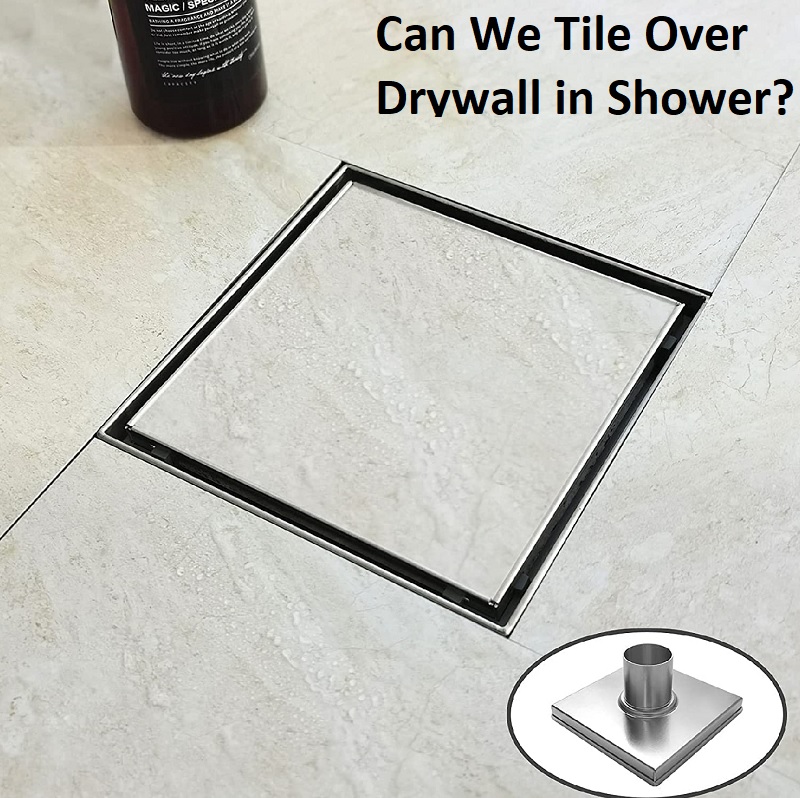It is not recommended to tile directly over drywall in a shower. Drywall is not a suitable substrate for tiling in wet areas because it is not waterproof and can absorb moisture, which can cause the drywall to deteriorate over time and lead to mold growth.
Instead, the recommended substrate for tiling in a shower is cement backer board or an equivalent waterproofing membrane. These materials are designed to withstand the moisture and humidity present in a shower and provide a stable surface for tile installation.
If you want to install tile in your shower, it’s best to remove the drywall and replace it with cement backer board or a waterproofing membrane before installing the tile. This will ensure that your shower tile lasts for many years to come and will not be susceptible to damage or mold growth.
Contents
Can We Put Tile on Drywall?
It is not recommended to install tile directly on drywall. Drywall is not an appropriate substrate for tile because it is not designed to withstand the weight and pressure of tile, and it is not waterproof. Moisture can seep through the grout and tiles and get absorbed by the drywall, leading to damage, mold growth, and failure of the tile installation.
Instead, the recommended substrate for tile installation is cement backer board or an equivalent waterproofing membrane. These materials are designed to withstand the weight and pressure of tile and to resist moisture, which is especially important in areas such as showers and bathroom walls.
If you are planning a tile installation, it is best to remove the drywall and replace it with an appropriate substrate before installing the tile. This will ensure that the tile installation lasts for many years to come and will not be susceptible to damage or failure.
Why Can’t You Tile Over Drywall in Wet Areas?
Tiling over drywall in wet areas is not recommended because drywall is not designed to withstand the moisture and humidity that are present in those areas. Drywall is made of gypsum, which is a porous material that can absorb moisture and promote the growth of mold and mildew. When water penetrates the grout and tiles, it can get absorbed by the drywall and cause it to deteriorate over time.
In addition, drywall is not strong enough to support the weight and pressure of tile. Over time, the weight of the tile can cause the drywall to sag, crack, and even collapse. This can lead to costly repairs and even safety hazards.
To avoid these problems, it is recommended to use a waterproof substrate such as cement backer board or an equivalent waterproofing membrane for tile installations in wet areas such as showers and bathroom walls. These materials are designed to resist moisture and provide a stable surface for tile installation. By using the right substrate, you can ensure that your tile installation lasts for many years to come and remains free of damage and mold growth.
How Do You Apply Drywall in Shower?
To cover drywall in a shower, you need to remove the drywall and replace it with an appropriate substrate that is designed to withstand the moisture and humidity present in a shower. Here are the general steps to follow:
- Remove the old drywall. Using a utility knife, cut through the drywall along the edges of the shower area, and then remove it using a pry bar or a hammer.
- Install a waterproof substrate. Cement backer board is the most commonly used substrate for shower walls. Cut the backer board to size using a circular saw, and then screw it to the studs using backer board screws and a power drill.
- Seal the joints. Use fiberglass mesh tape to cover the joints between the backer boards, and then apply thinset mortar over the tape using a trowel. Smooth out any bumps or ridges, and let the mortar dry overnight.
- Apply a waterproofing membrane. Use a paint roller to apply a waterproofing membrane over the backer board, making sure to cover all the seams and screw heads. Let the membrane dry for at least 24 hours before installing the tiles.
- Install the tiles. Apply thinset mortar to the backer board using a trowel, and then press the tiles into the mortar, using tile spacers to ensure even spacing. Once the mortar has set, remove the spacers and fill in the gaps with grout.
By following these steps, you can create a waterproof substrate for your shower tiles that will withstand the moisture and humidity present in a shower, and provide a stable surface for your tiles to adhere to.
Tips For Putting Tile Over Drywall in Shower
It is not recommended to put tile directly over drywall in a shower, but if you are planning to tile over drywall on a bathroom wall, there are a few tips to keep in mind to ensure a successful installation:
- Use the right type of tile: Not all tiles are suitable for use in wet areas. Porcelain, ceramic, or glass tiles are ideal for bathroom walls and have a low water absorption rate. Avoid natural stone tiles like marble or travertine, which are more porous and may absorb water over time.
- Prepare the drywall surface: Before tiling, it is important to make sure that the drywall is smooth and free of any bumps or ridges. Use a drywall sander or a sanding block to smooth out the surface, and then wipe it clean with a damp cloth.
- Use a high-quality adhesive: Choose a high-quality tile adhesive that is suitable for use in wet areas. Follow the manufacturer’s instructions for mixing and applying the adhesive, and use a notched trowel to spread it evenly over the drywall.
- Use a waterproof grout: It is important to use a waterproof grout in wet areas like showers to prevent water from seeping behind the tiles. Choose a grout that is designed for use in wet areas and follow the manufacturer’s instructions for mixing and applying it.
- Seal the edges: Once the tiles are installed and the grout has dried, it is important to seal the edges of the tile with silicone caulk to prevent water from seeping behind the tiles.
While tiling over drywall in a shower is not recommended, these tips can help you achieve a successful installation if you are installing tiles on a bathroom wall. However, for optimal results, it is recommended to use an appropriate waterproof substrate like cement backer board or a waterproofing membrane.

